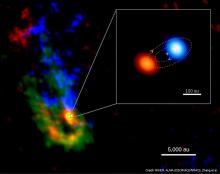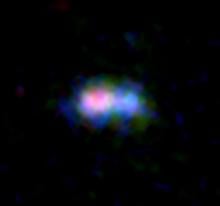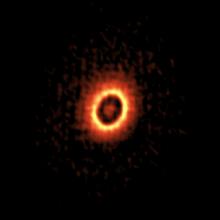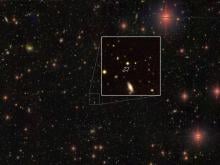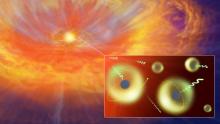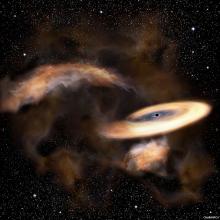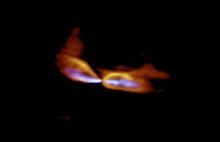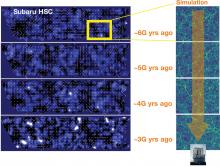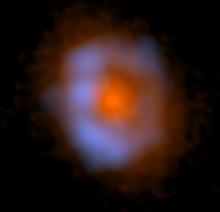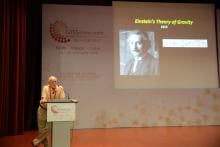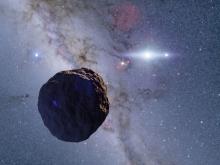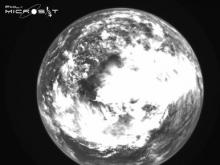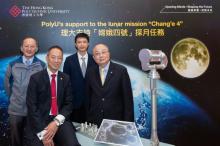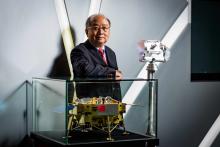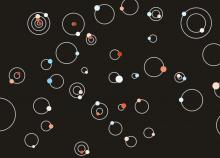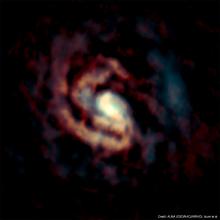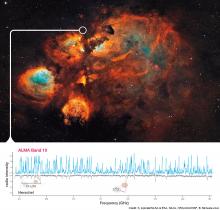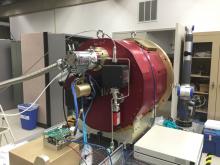Space
News
28 Mar 2019
Astronomers have found a molecular cloud that is collapsing to form two massive protostars that will eventually become a binary star system. This observations show that binary stars form together.

22 Mar 2019
The Hong Kong University of Science and Technology (HKUST) (HKUST) will build a new kind of camera using a new approach of quantum optics. The camera is set to help solve unanswered questions in astrophysics and cosmology, such as how light originates and varies around the black hole, in the hope of deciphering information emitted from there.
20 Mar 2019
Researchers have detected a radio signal from abundant interstellar dust in MACS0416_Y1, a galaxy 13.2 billion light-years away in the constellation Eridanus. Standard models can’t explain this much dust in a galaxy this young, forcing us to rethink the history of star formation.
13 Mar 2019
Researchers spotted the formation sites of planets around a young star resembling our Sun. Two rings of dust around the star, at distances comparable to the asteroid belt and the orbit of Neptune in our Solar System, suggest that we are witnessing the formation of a planetary system similar to ours.
13 Mar 2019
A team of astronomers has discovered 83 quasars powered by supermassive black holes (SMBHs) in the early Universe. This increases the number of black holes known at that epoch considerably, and reveals, for the first time, how common SMBHs were early in the Universe's history.
13 Mar 2019
A team of experts in nuclear fusion and astronomy has computed high-accuracy atomic data for analyzing light from a kilonova, a birth place of heavy elements. They found that their new data set could predict kilonovae brightness with much better accuracy than before. This aids our understanding of the cosmic origins of heavy elements.
28 Feb 2019
Astronomers have detected a stealthy black hole from its effects on an interstellar gas cloud. This intermediate mass black hole is one of over 100 million quiet black holes expected to be lurking in our Galaxy. These results provide a new method to search for other hidden black holes and help us understand the growth and evolution of black holes.
26 Feb 2019
Astronomers have unveiled the origins of two different gas streams from a baby star. Using ALMA, they found that the slow outflow and the high speed jet from a protostar have misaligned axes and that the former started to be ejected earlier than the latter. These indicate that streams were launched from different parts of disk around the protostar.
12 Feb 2019
Images of more than ten million galaxies are helping physicists map dark matter, revealing clues about how the universe behaves.
05 Feb 2019
Astronomers using ALMA have detected various complex organic molecules around the young star V883 Ori. A sudden outburst from this star is releasing molecules from the icy compounds in the planet forming disk.
31 Jan 2019
“It’s not that Newton’s theory was wrong,” says Professor Barry Barish, an experimental physicist from the California Institute of Technology and University of California, Riverside. “It was just incomplete and didn’t describe all of nature,” he says.
30 Jan 2019
The 2019 issue of Asia Research News magazine features fascinating advances in medicine, technology, social sciences, space and environment from across Asia.
29 Jan 2019
For the first time ever, astronomers have detected a 1.3 km radius body at the edge of the Solar System. Kilometer sized bodies like the one discovered have been predicted to exist for more than 70 years. These objects acted as an important step in the planet formation process between small initial amalgamations of dust and ice and the planets.
23 Jan 2019
Philippine microsatellite DIWATA-2 has successfully captured initial images. Launched last autumn, it is the second microsatellite designed and developed under a collaborative project between Hokkaido University, Tohoku University, the Advanced Science and Technology Institute (DOST-ASTI), and the University of the Philippines-Diliman (UPD)
14 Jan 2019
The Hong Kong Polytechnic University (PolyU) proudly supported the nation’s current lunar exploration, Chang’e-4 lunar probe, which successfully performed the historic landing on the far side of the Moon on 3 January 2019.
17 Dec 2018
A Japan-Spain team has developed a powerful 4-color simultaneous camera named MuSCAT2 for the 1.52-m Telescopio Carlos Sánchez at the Teide Observatory. The instrument aims to find transiting exoplanets, including Earth-like habitable planets orbiting stars near the Sun, in collaboration with NASA’s Transiting Exoplanet Survey Satellite.
10 Dec 2018
The Hong Kong Polytechnic University (PolyU) proudly supports the nation’s current lunar exploration, Chang’e-4 lunar probe, with advanced technologies.
04 Dec 2018
An international team of astronomers using a combination of ground and space based telescopes have reported more than 100 extrasolar planets (here after, exoplanets) in only three months. These planets are quite diverse and expected to play a large role in developing the research field of exoplanets and life in the Universe.
30 Nov 2018
Based on computer simulations and new observations from ALMA, researchers have found that the rings of gas surrounding active supermassive black holes are not simple donut shapes. Instead, gas expelled from the center interacts with infalling gas to create a dynamic circulation pattern, similar to a water fountain in a city park.
22 Nov 2018
ALMA has tuned in another new channel for signals from space. Using its highest frequency receivers yet, researchers obtained 695 radio signatures for various molecules in the direction of a massive star forming region. These first results from the ALMA Band 10 receivers developed in Japan ensure a promising future for high frequency observations.
25 May 2016
An international team of researchers is developing an instrument that will decode the light of the night sky to understand the nature of dark matter.
Events
Sorry, no events coming up for this topic.
Researchers
Sorry, no researchers coming up for this topic.
Giants in history
Chinese electron microscopy specialist Li Fanghua (6 January 1932 – 24 January 2020) facilitated the high-resolution imaging of crystal structures by eliminating interference.
Haisako Koyama (1916 – 1997) was a Japanese solar observer whose dedication to recording sunspots – cooler parts of the sun’s surface that appear dark – produced a sunspot record of historic importance.
Angelita Castro Kelly (1942-2015) was the first female Mission Operations Manager (MOM) of NASA. She spearheaded and supervised the Earth Observing System missions during its developmental stage.
Malaysia’s first astrophysicist, Mazlan binti Othman (born 11 December 1951) was instrumental in launching the country’s first microsatellite, and in sending Malaysia’s first astronaut, Sheikh Muszaphar Shukor, into space.
Meghnad Saha (6 October 1893 – 16 February 1956) was an Indian astrophysicist best known for formulating the Saha ionization equation which describes the chemical and physical properties of stars.
Subrahmanyan Chandrasekhar (19 October 1910 – 21 August 1995) was an Indian astrophysicist who studied the structure and evolution of stars.
Abdus Suttar Khan (c. 1941 – 31 January 2008) was a Bangladeshi engineer who spent a significant part of his career conducting aerospace research with NASA, United Technology and Alstom.
Bibha Chowdhuri (1913 – 2 June 1991) was an Indian physicist who researched on particle physics and cosmic rays. In 1936, she was the only female to complete a M.Sc. degree at the University of Calcutta.



